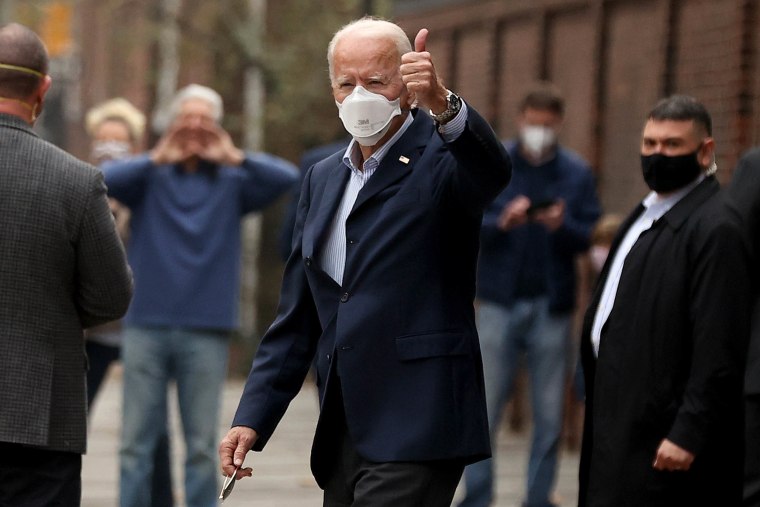Following Joe Biden's prostate cancer diagnosis, all eyes are on the former president's health.
On May 18, the 82-year-old's office announced he has an "aggressive form of the disease" that has spread to the bone.
According to the statement, Biden sought medical care after experiencing “increasing urinary symptoms.” His medical team then discovered the cancer after finding a prostate nodule.
As Biden reviews treatment options with his family, his team has shared a few details about his prognosis. Below, we're outlining everything you need to know about his condition, as well as the other health challenges he's faced over the years.
2025: Biden was diagnosed with prostate cancer
 The former president has an "aggressive" form of prostate cancer.Yuri Gripas / Bloomberg via Getty Images
The former president has an "aggressive" form of prostate cancer.Yuri Gripas / Bloomberg via Getty ImagesIn order to determine how quickly prostate cancer is growing, doctors use a system called the Gleason score and grade group. Biden's cancer has a Gleason score of 9 and is Grade 5, meaning it's a "very high grade," per the Mayo Clinic.
“While this represents a more aggressive form of the disease, the cancer appears to be hormone-sensitive which allows for effective management,” the statement from Biden's office read.
On May 19, 2025, the former president addressed his supporters in an Instagram post, writing, “Cancer touches us all. Like so many of you, Jill and I have learned that we are strongest in the broken places. Thank you for lifting us up with love and support."
Per the Mayo Clinic, prostate cancer doesn't always cause symptoms at first, and most cases are discovered at an early stage. Early stage symptoms include the following:
- Blood in the urine and semen
- Increased need to urinate, especially overnight
- Difficulty starting to urinate
2025: Biden addressed rumors of cognitive decline
Throughout his presidency, Biden encountered questions about his mental acuity. In February 2024, he responded to accusations that he was experiencing memory loss after special counsel Robert Hur issued a report on the president's handling of classified information.
Per NBC News, the report claimed Biden's memory was “significantly limited, both during his recorded interviews with (a) ghostwriter in 2017, and in his interview with our office in 2023."
The report also claimed that Biden didn't remember when his son Beau had died.
“How in the hell dare he raise that?” Biden said in response during a February 2024 White House press conference.
“I don’t need anyone to remind me when he passed away,” Biden added.
In May 2025, the former president responded to a new book that dives into his mental fitness for office and his team's response to public concern about his health during the 2024 presidential campaign.
In the book, titled "Original Sin," journalists Jake Tapper and Alex Thompson claim that Biden didn't recognize George Clooney, who he had known for years, at an event.
During an interview with ABC's "The View," Biden offered the following response to rumors that he experienced cognitive decline as president.
“They are wrong,” he said, per NBC News. “There’s nothing to sustain that.”
2024: Biden's physical details atrial fibrillation, acid reflux, stiffened gait
After Biden underwent a routine physical in 2024, his physician, Dr. Kevin C. O’Connor, outlined the status of the president's health in a letter obtained by NBC News.
The doctor noted that Biden was "fit for duty" but experienced the following conditions: acid reflux, a stiffened gait due to a previous foot fracture and asymptomatic atrial fibrillation.
2023: Biden started using a CPAP machine for sleep apnea
The former president began using a continuous positive airway pressure (CPAP) machine in 2023 to treat his sleep apnea, per NBC News.
According to the Mayo Clinic, sleep apnea is a "potentially serious sleep disorder in which breathing repeatedly stops and starts."
Doctors often prescribe the use of a CPAP machine to help patients manage their condition. Per the Mayo Clinic, the machine "delivers just enough air pressure to a mask to keep the upper airway passages open, preventing snoring and sleep apnea."
Biden's history of sleep apnea dates back to 2008, per NBC News.
2023: Biden had a basal cell carcinoma removed
During a routine physical exam in 2023, Biden had a skin lesion removed from his chest. Per NBC News, doctors later determined it to be cancerous and labeled as basal cell carcinoma.
The Mayo Clinic defines the condition as a type of cancer that originates in basal cells, aka "a type of cell within the skin that produces new skin cells as old ones die off."
According to the White House physician, no additional treatment was necessary as "all cancerous tissue was successfully removed."
2022 and 2024: Biden tested positive for COVID-19
 Biden in 2020. Chip Somodevilla / Getty Images
Biden in 2020. Chip Somodevilla / Getty ImagesAt the age of 79, Biden tested positive for COVID-19 in July 2022. He was fully vaccinated and had received two booster shots at the time. White House press secretary Karine Jean-Pierre described the president's symptoms as "very mild" and said he was prescribed Paxlovid, an antiviral pill.
Two years later, Biden tested positive for COVID-19 once again in July 2024. Jean-Pierre described his symptoms as "mild" and said he was returning to Delaware to "self-isolate."
2021: Biden had a colon polyp removed
While Biden was undergoing a colonoscopy procedure in 2021, doctors removed a polyp from his colon. The White House physician described the nature of the polyp in a letter, calling it a “benign, slow-growing but thought to be precancerous lesion,” per NBC News.
In the letter, O’Connor said the polyp was a “tubular adenoma,” which the Cleveland Clinic defines as a “precancerous” polyp that is often found during routine colonoscopies.
“Even though fewer than 9% of tubular adenomas become cancer, learning you have them might be like getting a very early warning you have a higher risk of developing colorectal cancer. That early warning could help you reduce your risk,” the clinic’s website reads.
Per NBC News, the polyp was similar to one the former president had removed in 2008.
2020: Biden experienced a foot fracture
 President Biden at the White House in 2024.Anna Moneymaker / Getty Images
President Biden at the White House in 2024.Anna Moneymaker / Getty ImagesWhile playing with his German shepherd Major in 2020, Biden sprained his right foot and experienced hairline fractures. Per NBC, the fractures occurred to the “lateral and intermediate cuneiform bones in the midsection of his right foot."
2003: Biden had his gallbladder removed and was diagnosed with atrial fibrillation
In 2003, Biden underwent emergency surgery to remove his gallbladder. Per the New York Times, he was on vacation in Florida with his family then began experiencing abdominal pain.
According to the Associated Press, 2003 was also the year Biden first began having episodes of atrial fibrillation, which the Mayo Clinic defines as "an irregular and often very rapid heart rhythm" that can lead to blood clots in the heart. It also "increases the risk of stroke, heart failure and other heart-related complications."
In 2019, Biden's doctor described the state of his condition as "persistent" but said tests showed his heart was functioning normally. To manage the condition, he was on a blood thinner.
In 2024, a White House doctor described Biden's atrial fibrillation as "asymptomatic."
1988: Biden experienced 2 brain aneurysms and a blood clot in his lungs
 Biden leaves Walter Reed Army Hospital after brain blood clot surgery in 1988.Bettmann Archive
Biden leaves Walter Reed Army Hospital after brain blood clot surgery in 1988.Bettmann ArchiveBiden had several serious health scares in 1988, including two brain aneurysms and a blood clot in his lung.
Brain aneurysms
Doctors initially diagnosed Biden with a pinched nerve in 1988 after he had been experiencing headaches for around a year, per The Washington Post. However, he later experienced two brain aneurysms.
According to the Mayo Clinic, an aneurysm is a "bulge or ballooning in the wall of a blood vessel" that can "break open," causing bleeding inside the body and potential death.
The health scare took place during Biden’s first presidential run and started when he felt an “electric surge inside his head” one morning, per the Post. At the hospital, doctors learned that an aneurysm had burst and blood was pooling at the base of his brain.
After Biden was transferred to Walter Reed Army Medical Center in Washington, D.C., a neurosurgeon discovered a second aneurysm that hadn’t burst yet.
Following the diagnosis, Biden underwent two surgeries to remedy the aneurysms, per the New York Times. At the time, a spokesperson for the medical center said the second aneurysm was smaller than the first.
Blood clot
Biden was treated for a blood clot in his lung in 1988, per The Washington Post. The clot came one month after the then-senator underwent emergency surgery for the first aneurysm. At the time, bed rest following the surgery was thought to have led to the subsequent clot.
Chrissy Callahan is a writer for Today.com.








 English (US) ·
English (US) ·